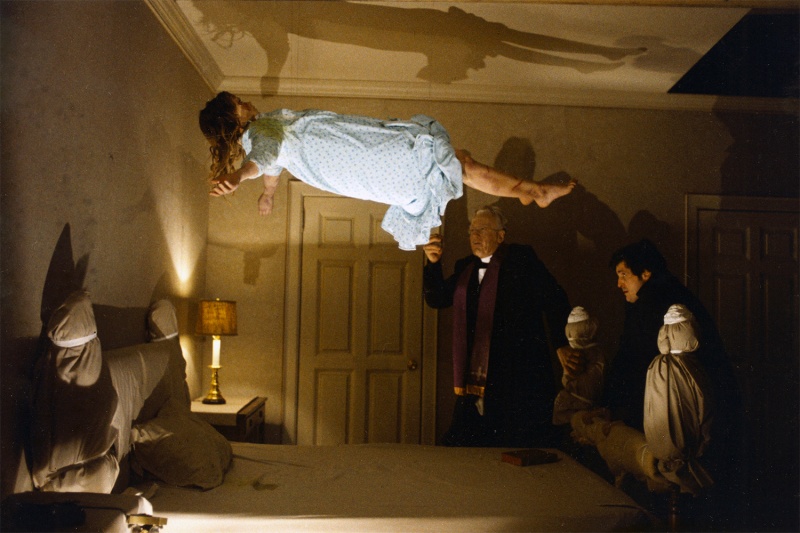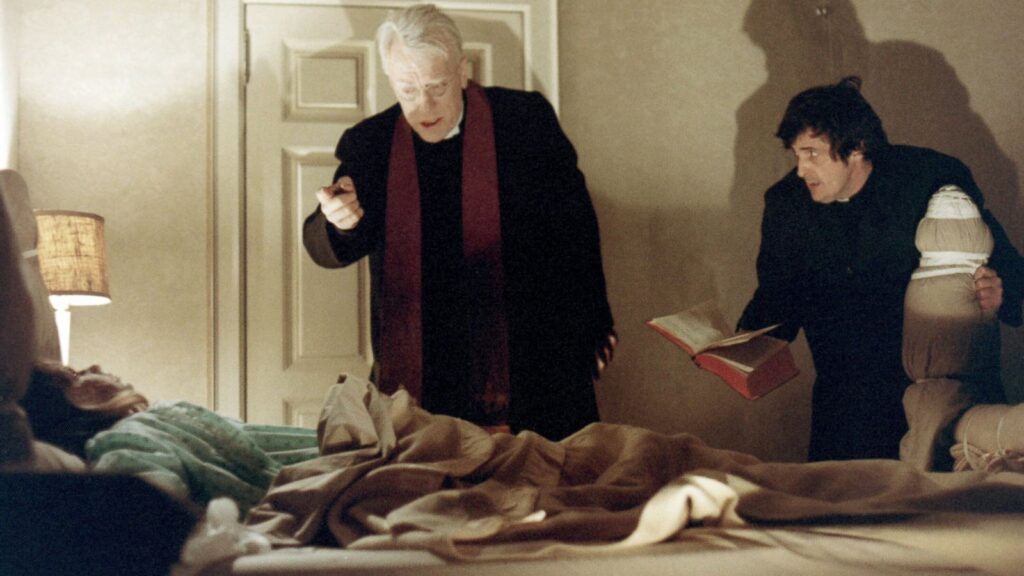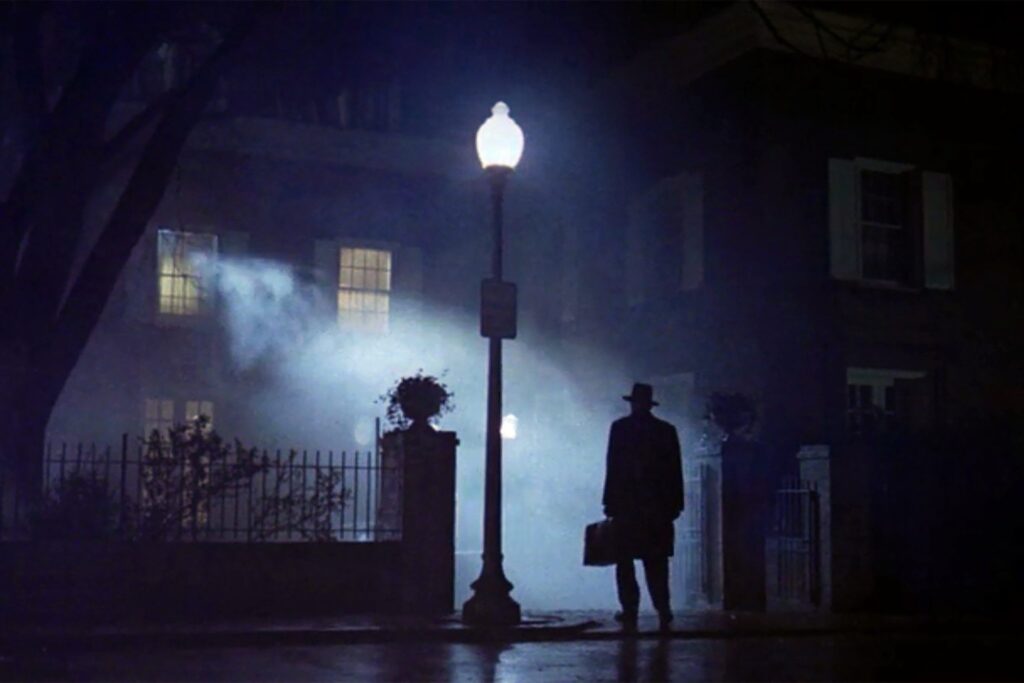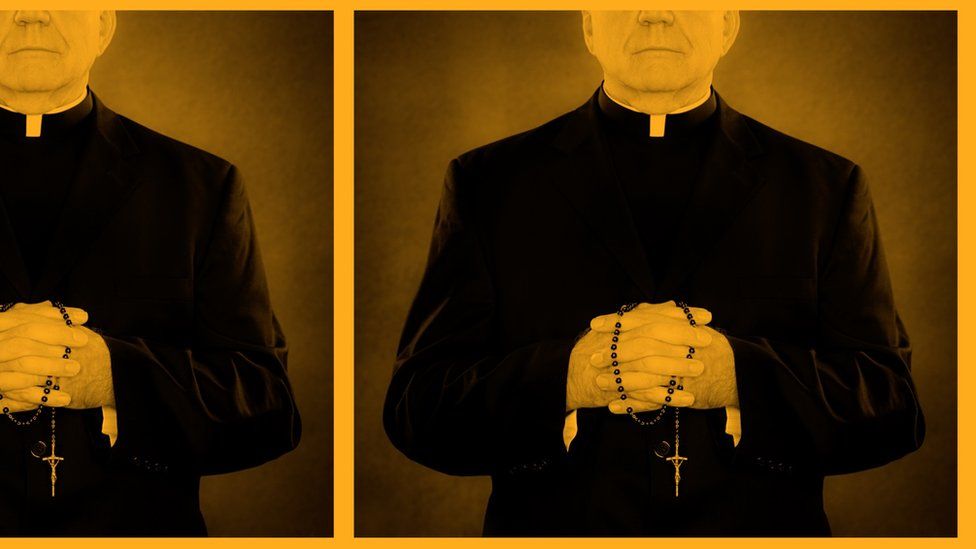Exorcists, Abusers, and When Catholic History is Horror
Part two of a three-part series comparing Catholic horror films and novels to actual horrors committed by the Catholic Church

(Image: A scene from the 1973 film The Exorcist)
About the Catholic Horrors Series: For the past two centuries, Catholicism has played a special role in American horror stories. During that time, the Catholic Church has been complicit in real-life horrors. In this three-part series, three scholars of American Catholicism – Jack Lee Downey, Matthew Cressler, and Kathleen Holscher – consider Catholic horror as a cinematic and literary genre alongside horrors committed by the Catholic Church and its leaders. In so doing, they explore horror as an aesthetic and as a way to analyze and confront the shadow side of Catholicism in North America. Read part one here.
***
Warning: What you are about to read is true and involves Catholic clerical sexual abuse.
The priest arrived at night. The mother was surprised to see him there so late. She let him in all the same. A much younger priest met him in the foyer. He spoke in hurried tones about the woman’s daughter. The elder priest stopped him. “I believe we should begin.” The younger frowned. “You mean now? Right away?” “Yes, I think so.” So the mother led them up the stairs. They entered a room where a twelve-year-old girl lay strapped to the bed. The men shut the door. They were alone with her now. They got to work.
So begins the climactic scene in The Exorcist—both William Peter Blatty’s bestselling 1971 novel and William Friedkin’s 1973 cinematic classic. By the time these priests begin the rite of exorcism, audiences have witnessed a mother and daughter’s life fall apart. Regan is a cheerful young girl at the start of the story. She soon finds herself possessed by a demon. Her mother, Chris MacNeil, tries and fails to help her. She brings Regan to psychiatrists and other medical professionals to no avail. With nowhere else to go, Chris turns to the Catholic Church. She urges a young Jesuit priest and psychiatrist, Father Damien Karras, to intervene. Only after he determines that Regan’s situation “meets the conditions set forth in the Ritual” does he consent to an exorcism. Jesuit Father Lankester Merrin, the titular exorcist, arrives at the MacNeil home right in the nick of time to battle the demon and attempt to purge Regan of Evil.
Hence we find two priests alone in a room with a twelve-year-old girl. It makes perfect sense in the story. Absent this context, however, this is the stuff of real-life horror. Variations on this scene have played out hundreds of thousands of times (at least) in countries across the world for the better part of the past century. They still do. When we encounter The Exorcist with full knowledge of Catholic clerical sexual abuse it’s hard not to notice resonances between Catholic horror as a genre and Catholic horrors in history. As Jack Lee Downey notes in the inaugural essay in this series, “public attentiveness to clerical abuse” has sparked a resurgence of Catholic horror “with priest villains counterbalancing The Exorcist-style cosmic superheroes.”

(Image: A scene from The Exorcist)
Nevertheless, hero priests (and their lay Catholic surrogates) remain central to the horror genre today. Catholics, and priests in particular, often seem to be the only characters in horror movies capable of seeing Evil for what it truly is and sending it back to Hell. Reading horror and history together, however, reveals something much more disturbing than any scary movie: it is not a coincidence that thousands of actual priests preyed on and abused victims while crowds packed theaters to watch fictional priests deliver them from the Devil. The very same spiritual power that propels hero priests in horror enabled predator priests to abuse with impunity.
The Hero Priests of Horror
Fathers Merrin and Karras rank first and second on Screenrant’s “10 Most Badass Priests in Horror Movies.” This listicle gives a good survey of hero priests over the years. Of course, horror did not invent the priestly protagonist. As religious studies scholar Anthony Smith illustrates in The Look of Catholics, the middle decades of the twentieth century were a heyday for Catholics in American cinema. Bing Crosby won an Oscar for his performance as Father O’Malley in Going My Way (1944), and was nominated again when he reprised the role in The Bells of St. Mary’s (1945). But horror established a special role for priests. The Exorcist was crucial in this regard. As film critic Steven D. Greydanus notes in an essay for Decent Films, it provided “a pivotal link from the Catholic-inflected piety of Golden Age Hollywood and the demonic world of latter-day horror.” Priests have been key for the genre ever since, facing down ghosts, demons, vampires, and even the occasional interdimensional entity.
Here’s how the hero priest works in horror. The story inevitably starts with weird things happening—scratching in the walls, knockings at the door, strange smells, pets dying—but our unsuspecting victims assume there must be some reasonable explanation. Rats in the attic, perhaps. Or maybe it’s mental illness. The hero priest arrives to prove, both to the fictional victims and to the audience, that Evil with a capital E is at work. The problem is not your house, he declares, nor is it in your head. Some Thing is here! Skeptics aren’t so easily convinced, and the hero priest must do his due diligence and investigate. When the case is made beyond a shadow of a doubt, he springs into action and deploys an arsenal of Catholic paraphernalia—crucifixes, holy water, rosaries, you name it—to save the day.

(Image: A priest arriving at night to perform an exorcism in The Exorcist)
This narrative arc—from doubt to belief to heroic intervention—contains an argument about the Catholic Church in the modern world. It makes a case for the reality of the supernatural and, in doing so, reinforces the power of the “one true Church” with access to it. In this sense, the hero priest is an instrument against (what is perceived to be) an increasingly disenchanted world and an embodiment of nostalgia for a world populated by angels and demons.
The Exorcist set the template for this trope, but it has played out repeatedly over the past fifty years. The hero priest in Stephen King’s ‘Salem’s Lot (1975) openly disdains his clerical contemporaries for whom true “EVIL” has been reduced to the social and political problems of the postmodern world. “The Catholic Church has been forced to reinterpret its whole approach to evil,” Father Callahan laments in the novel. “[B]ombers over Cambodia, the war in Ireland and the Middle East, cop-killings and ghetto riots, the billion smaller evils loosed on the world each day like a plague of gnats.” Callahan yearns to wage war against the real forces of darkness. (His wish will come true by the end, and quite tragically.)
More recently, the Conjuring Universe offers a new iteration of this argument for the clear and present danger of supernatural evil. The massively successful horror franchise is built around the exploits of Ed and Lorraine Warren, a real-life husband-and-wife pair of paranormal detectives (portrayed in the movies by Patrick Wilson and Vera Farmiga). Here the role of “hero priest” is taken up by a lay Catholic couple. The Conjuring (2013) identifies Lorraine as “a gifted clairvoyant” and her husband as “the only non-ordained Demonologist recognized by the Catholic church.” This first film makes the case for supernatural realness in classic based-on-a-true-story fashion, weaving historical photographs into the end credits sequence as “evidence.” The movie ends with an epigraph:
“Diabolical forces are formidable. These forces are eternal, and they exist today. The fairy tale is true. The devil exists. God exists. And for us, as a people, our very destiny hinges upon which one we elect to follow.” – Ed Warren
Whether one follows the devil or God, the film seems to say, they exist and we ignore them at our own peril.
Supernatural horror is appealing for so many because it blurs the boundaries of what is real. (Christina Pasqua explores this dimension of horror in her review of Rose Glass’s Saint Maud.) Once again, The Exorcist set the standard in this regard. Blatty based his novel on the true story of a boy who underwent a ritual exorcism. Friedkin directed the film as if it was a documentary. This is what made it so terrifying. It also appalled many critics. As religious studies scholar Colleen McDannell notes, some critics didn’t know what to do with a film that didn’t use “demonic possession as a metaphor” but instead “was actually about demonic possession.” This reading of The Exorcist as real has been passed on from generation to generation. In her 2017 memoir Priestdaddy, writer Patricia Lockwood recalls her father introducing the film to her like this: “This story is absolutely true, it happened right in St. Louis, and it will one day happen again….This was not a psychological disturbance. This was not puberty. Don’t listen to the shrinks. This was the presence of evil, pure and simple.”
Abuser Priests in History
The premise that propels Catholic horror is that the Church and its clerics are the only forces with the power to go toe to toe with true Evil. That idea runs parallel to the logic that allowed Catholic clerical sex abuse to run rampant: the Church and its priests stand in the place of God on Earth, literally. Reading The Exorcist alongside clerical abuse illuminates these mirror logics. It is, therefore, imperative that we speak concretely. Religious studies scholar Brian Clites argues that this is one way to hold ourselves accountable to survivors: by attending “to the specific dynamics that formed each survivor and each abuser.”
There are tragically countless survivors and abuser priests we could discuss. Since The Exorcist is set in the shadow of Georgetown University and centers Jesuits, we could read it alongside the fourteen priests, most of them Jesuits, associated with the university who have been credibly or plausibly accused of abuse. Or we could discuss the case of David Morrier, the former friar whose abuse of a female student at the Franciscan University of Steubenville included acts termed “exorcism” under Church law. But I’d like to sit with the specificity of what survivors revealed about Father Nicholas V. Cudemo. Terry McKiernan, founder of Bishop-Accountability.org, a website dedicated to documenting the Roman Catholic abuse crisis, introduced me to this abuser priest’s file. I will never forget what I read there. It raises a crucial question for our consideration: what do we do when history reads like a horror story?
(A note to readers: The primary sources linked below come courtesy of Bishop-Accountability.org. Pseudonyms correspond to those assigned in the 2005 Philadelphia grand jury report. Tom Roberts’ and Michael Newall’s reporting on the trial and investigation provides useful context. Those interested in exploring the sources should be warned: some of the details in the files, and in what follows, are graphic.)
Born in 1936, Nicholas Cudemo was ordained as a priest in 1963 by the Archdiocese of Philadelphia. His history of reported abuse began in 1964. We know this because an anonymous parishioner wrote a letter informing then-archbishop John Joseph Krol “that one of our young priests, ordained only a few years, has been involved in a love affair.” It seemed an open secret that this thirty-year-old assistant pastor had a sexual relationship with a teenage girl, “a junior at our Lansdale Catholic High School.” He joined the faculty of St. John Neumann High School in 1968 and was transferred to Archbishop Kennedy High School before the school year ended. Around that time a fellow priest instructed Cudemo to be “extremely careful in his behavior with girls” after he witnessed Cudemo “trying to calm an hysterical girl” who “had a ‘crush’ on him.” A month later Cudemo was caught taking a different “young woman to his room for a half hour with the door closed.” Like the unexplained happenings at the start of a horror movie, warning signs were scattered across his first decade of ministry. Like a haunting misattributed to creaky floorboards, abuse was classified as a “love affair” and dismissed as the “crush” of a “hysterical girl.” Signs of what was to come were filed away in an archdiocesan secret archive.

(Image source: Getty Images)
The year The Exorcist opened in theaters Cudemo moved to Cardinal Dougherty Catholic High School, his third school assignment in five years. “Particular friendships” with female students, as archdiocesan officials termed them, motivated these transfers. We know this because of the bravery of the survivors and their supporters who tried to stop him. In 1977, a mother and daughter informed then-Chancellor Francis Statkus that Cudemo was having sex with a high schooler and potentially two of his own nieces. Over the next fifteen years, cardinal archbishop Anthony Bevilacqua would make Cudemo pastor of a parish twice despite no less than four separate reports of sexual misconduct.
The full extent of the horrors Cudemo perpetrated came to light in the fall of 1991 when five women came forward. As summarized by a 2005 grand jury report, between 1964 and 1989 “Father Cudemo raped an 11-year-old girl, molested a fifth grader in the confessional, invoked God to seduce and shame his victims, and maintained sexually abusive relationships simultaneously with several girls from the Catholic school where he was a teacher.”
This is where I want to pause and take a breath, on the edge of the abyss. What these women told archdiocesan officials was deeply upsetting. It was disgusting. It was also frighteningly familiar for anyone who has seen a Catholic horror movie. In The Exorcist, sexual violence is central to the portrayal of Regan MacNeil’s transformation from daughter to disfigured monster. It is ostensibly a demon who harms this girl, yet what audiences witness looks like self-violence. This is precisely what makes it so shocking. The most infamous scene is when a possessed Regan masturbates with a crucifix, shouting “Yes, let Jesus fuck you, fuck you fuck you!”
Much more shocking than this movie clip is how it echoes real-life abuse. Abuser priests, Cudemo among them, drew on their spiritual authority to groom victims and assuage others. They used religious objects in their abuse. They relied on the institutional power of their office to protect them. Cudemo first raped Ruth, one of the survivors who spoke out in 1991, when she was 11 years old. He would hear her confession afterward, insisting that “only after confessing was she ‘worthy of God’s love.’” He invited other priests to rape her. He occasionally incorporated the Eucharist into ritual acts of rape, telling her “she had ‘fucked God’ or ‘fucked Jesus.’” He called her a “walking desecration.” Cudemo abused Ruth from 1971 until 1977.
Cudemo resigned in 1996, but Cardinal Bevilacqua permitted him to minister and say Mass as a retired priest in “good standing.” Cudemo died in 2021. Ruth continues to live with the traumatic consequences of these events today, as do the other survivors of his abuse.
Again, what do we do when history reads like horror? I do not mean this as a euphemism, as a fancy way of saying “something terrible happened.” I mean, quite seriously, what do we do when history mirrors the horror genre’s conventions? William Peter Blatty may not have drawn details from contemporaneous clerical abuse to characterize demonic possession, but even if the connection is not causal that does not mean it’s accidental. Hero priests of horror and abuser priests in history emerge, in part, from a common source: the presumed supernatural power of the priesthood. In the 1973 film, Fathers Merrin and Karras famously command the demon, saying “THE POWER OF CHRIST COMPELLS YOU!” In 1970s Philadelphia, Father Cudemo invoked that same power as he coerced and abused a dozen girls (that we know of). The spiritual authority that empowers hero priests on the silver screen is intimately bound up with the religious authority that enabled abuser priests to prey on and violate their victims.
***
The public’s awareness of rampant clerical sexual abuse is one reason why horror films are starting to subvert the trope of the hero priest—sometimes deconstructing it altogether. The Conjuring Universe recasts the archetypal priest as a married lay couple and caricatures the Church as a hamstrung bureaucracy. (In the first film, the Vatican “approves” an exorcism only after Ed Warren has already taken matters into his own hands and saved the day.) In the 2021 Netflix series Midnight Mass, it is the priest who brings home a monster that devours his community and, as I’ve written elsewhere, there are scenes that dramatize deference to male clerical authority in terrifying fashion. And there is no priest at all in arguably the most compelling Catholic horror film of the past decade, Saint Maud (2021).
The most effective and affecting takedowns of the hero priest myth, however, are those created by survivors of clerical sex abuse themselves. While the 2021 collaborative documentary Procession is not horror per se, the stories survivors tell draw on its conventions and aesthetics. Here, six survivors—Joe Eldred, Mike Foreman, Ed Gavagan, Dan Laurine, Michael Sandridge, and Tom Viviano—work with director Robert Greene, their lawyer Rebecca Randles, and drama therapist Monica Phinney to produce short films that help them process their abuse and its impact on their lives.
For filmmaker Skip Shea, himself a survivor, the genre serves as an ideal space to confront evils that are often too painful for audiences to engage in other settings. He plays on this powerfully in the 2019 short film Priest Hunter, whose title is rather self-explanatory, as well as in the feature-length 2016 psychological horror film Trinity, in which an artist’s chance encounter with the priest who abused him triggers a surreal, nightmarish journey into his past.
Countering the conclusion to The Exorcist—in which we’re told Regan “doesn’t remember any of it”—these important films compel a confrontation with the real-life horrors wrought by Catholics and their church. They refuse to let us forget.
Visit Bishop-Accountability.org to research the abuse crisis in the Roman Catholic Church.
Matthew J. Cressler is associate professor of religious studies at the College of Charleston. He is the author of Authentically Black and Truly Catholic: The Rise of Black Catholicism in the Great Migrations (NYU Press, 2017) and has written for The Atlantic, Slate, America, Zocalo Public Square, Religion News Service, and The Revealer.